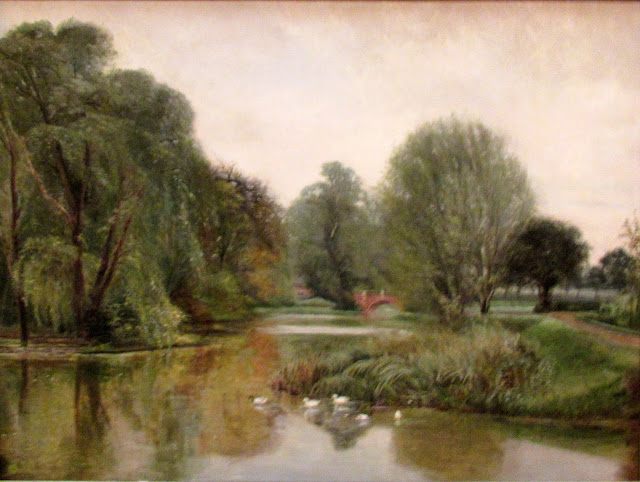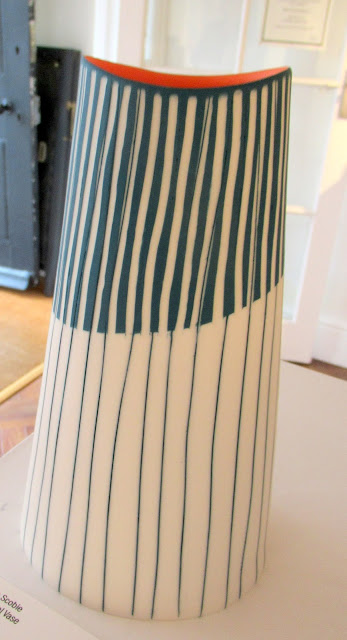Leamington Museum and Art Gallery, the permanent collection.
It was wonderful being able to visit a gallery after a six-month break. We had a look at the permanent exhibition in the gallery, as well as the temporary one, which will be the subject of another post.
In the permanent collection we saw some pieces we had seen before, and some new ones too.
Jan de Bray was based in Haarlem in the Netherlands for most of his career. He specialised in portraiture and history painting, then later also worked as an architect.
During WWII John Piper was employed as an official war artist to record buildings and landscapes which were in danger of being destroyed.
David Fraser has written: 'The interior... glows with a strange gold and reddish light in the chancel, pulpit and the vaults, bringing to mind not just these churchy terms but a feeling of the aged and long-term worship that has been witnessed there, so much so that it seems full of the liturgy and the spoken word'.
Henry Scott Tuke, The Critics, 1927, (oil on board)
A founding member of the Newlyn School in Cornwall, Tuke subsequently moved further up the coast to Falmouth. This painting shows one of his favourite themes, the adolescent male nude, painted en plein air. Tuke's treatment of the boys' awkward poses and elongated limbs, reveals his development away from the idealism associated with the classical male nude.
Bernard Ninnes, Boat Builders Shop, St Ives, (oil on canvas)
This painting depicts an old boat building workshop on Wharf Road, St Ives, which was demolished soon after this work was completed. Although the interior is dilapidated, the bright light from the window illuminates the scene, giving it a sense of cathedral-like monumentality.
Ninnes studied in Paris and at the Slade School of Art in London before moving to St Ives, where he later became vice-president of the St Ives Society of Artists. This painting was noted in the St Ives Times as being the picture which 'proclaimed to St Ives artists... the arrival of a newcomer with courage in colour, and something different in technique'.
Gerald Vidal, Corsica, 1930s (oil on canvas)
Dorothea Sharp, Where Children Play and Seagulls Fly, (oil on canvas)
The broad brushstrokes and vibrant colours of Sharp's work convey a happy and contented idyll in which the sun always shines. Her style was inspired by Claude Monet, whose work she first saw in the late 1890s and which led her to abandon her more conventional approach to painting by adopting a more brilliant palette.
This painting was completed while Lowry was looking after his bed-bound mother, who did not understand her son's obsession with painting. Although he attended evening classes at the Municipal College of Art and later Salford School of Art, Lowry considered himself to be self-taught.
Tessa Beaver was a prolific artist. She was born in 1932 and worked continuously as a print maker and painter following her graduation from the Slade School of Art in 1953. Beaver focused much of her work on natural themes.
Edmund de Waal, Water-shed, 2010 (white lacquer, wood and ceramics)
Water-shed was commissioned for an exhibition of the same name which took place at Leamington Spa Art Gallery and Museum in 2010. It was inspired by the history of the Royal Pump Rooms as a place where medical treatments, including hydrotherapy, were administered.
The white lacquered cabinet is filled with dark celadon blue pots. It was created as a modern version of both the domestic medical cabinet and a recreation of an old-fashioned doctor's carrying case. The work also references the different ways in which vessels have been used to hold water. Each vessel has a different coloured glaze with finishing touches of platinum leaf. The artist created new aquatic celadon glazes for this work which were designed to catch the light.
John Bridgeman, Horse and Jockey, (bronze)
Frederick Whitehead, The Leam near the Willes Road Bridge, (oil on canvas)
The river running between Jephson Gardens and the Mill Gardens, which I often visit during my walks.
Mark Tichner, We Want Responsibility to Be Shared By All, (oil based inkjet on aluminium)
In 2003 Transport for London commissioned Tichner to produce ten giant billboard works to be exhibited at Gloucester Road tube station as part of the 'Platform for Art' programme.
Marc Quinn, Catherine Long, 2002 (Macedonian marble)
Catherine Long is one of a series of portraits Quinn created of people with missing or malformed limbs caused by illness, accident or birth. The works were conceived while Quinn was looking at sculpture in the British Museum and considering 'how people impute an inside to someone from a reading of their outside'. The post was selected by both artist and model. Long was keen to be involved in the project, feeling that 'it would evoke and challenge people's perceptions of what they see as being beautiful or not beautiful'.
Christine Borland, Set Conversation Piece, 1998, (bone china)
Borland has worked intensively with the police, forensic scientists and medical experts, creating a strong relationship between science and art. Set Conversation Piece is part of a body of work called English Family China in which she reflects on the meaning of bone china, a type of ceramic incorporating ground bone.
The skull of an infant, seen here next to the pelvis, can be positioned ready for birth. The two are linked by the same blue hand painted decoration which refers to the ways in which genetic pattern run through a family. The decoration is copied from 18th century Liverpool pottery as the work was originally made for an exhibition at Tate Liverpool. The ships are shown sailing from Liverpool carrying emigrants, sugar and slaves to commemorate Liverpool's power as a port.


Terry Frost, Untitled, Maquette for University Hospitals Coventry and NHS Warwickshire Trust NHS, 2003, (painted steel)
When Frost died he was working on a commission for a large scale sculpture for new University Hospital of Coventry and Warwickshire, due to open in 2006. The financial implications were complicated and eventually this commission did not happen. The design is a manifestation of the shapes visible in Frost's two dimensional work. One can only imagine how impressive a nine foot version of this sculpture would have looked at the entrance to the hospital.

















































